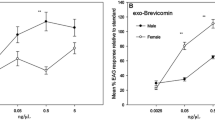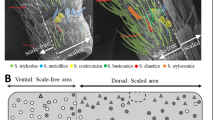Abstract
In laboratory and field bioassays, the response ofDendroctonus frontalis was significantly greater to the mixture of (1S, 5R)-(−)-frontalin andalpha-pinene than to (1R,5S)-(+)-frontalin andalpfa-pinene. Electro-physiological studies revealed that antennal olfactory receptor cells were significantly more responsive to (1S, 5R)-(−)-frontalin than to (1R, 5S)-(+)-frontalin. Both enantiomers stimulated the same olfactory cells which suggests that each cell possesses at least two types of enantiomer-specific acceptors.
Similar content being viewed by others
References
Birch, M.C., Light, D.M., Wood, D.L., Browne, L.E., Silverstein, R.M., Bergot, B.J., Ohloff, G., West, J.R., andYoung, J.D. 1980. Pheromonal attraction and allomonal interruption ofIps pini in California by the two enantiomers of ipsdienol.J. Chem. Ecol. 6:703–717.
Boeckh, J. 1962. Elektrophysiologische Untersuchungen an einzelnen Geruchsrezeptoren auf den Antennen des Totengräbers (Necrophorus, Coleoptera).Z. Vergl. Physiol. 46:212–248.
Borden, J.H., Chong, L., McLean, J.A., Slessor, K.N., andMori, K. 1976.Gnathotrichus sulcatus: Synergistic response to enantiomers of the aggregation pheromone sulcatol.Science 192:894–896.
Borden, J.H., Handley, J.R., McLean, J.A., Silverstein, R.M., Chong, L., Slessor, K.M., Johnston, B.D., andSchuler, H.R. 1980. Enantiomer-based specificity in pheromone communication by two sympatricGnathotrichus species (Coleoptera: Scolytidae).J. Chem. Ecol. 6:445–456.
Byrne, K.J., Swigar, A.A., Silverstein, R.M., Borden, J.H., andStokkink, E. 1974. Sulcatol: Population aggregation pheromone in the scolytid beetle,Gnathotrichus sulcatus.J. Insect Physiol. 20:1895–1900.
Dickens, J.C. 1981. Behavioural and electrophysiological responses of the bark beetle,Ips typographus, to potential pheromone components.Physiol. Entomol. 6:251–261.
Dickens, J.C., andPayne, T.L. 1977. Bark beetle olfaction: Pheromone receptor system inDendroctonus frontalis.J. Insect Physiol. 23:481–489.
Harring, C.M., andMori, K. 1977.Pityokteines curvidens Germ. (Coleoptera: Scolytidae): Aggregation in response to optically pure ipsenol.Z. Angew Entomol 82:327–329.
Hedden, R.L., Vité, J.P., andMori, K. 1976. Synergistic effect of a pheromone and a kairomone on host selection and colonization byIps avulvus.Nature 261:696–697.
Iwaki, S., Marumo, S., Saito, T., Yamada, M., andKatagiri, K. 1974. Synthesis and activity of optically active disparlure.J. Am. Chem. Soc. 96:7842–7844.
Kinzer, G.W., Fentiman, A.F., Jr., Page, T.F., Foltz, R.L., Vité, J.P., andPitman, G.B. 1969. Bark beetle attractants: Identification, synthesis and field bioassay of a new compound isolated fromDendroctonus.Nature 221:477–478.
Klimetzek, D., Loskant, G., VitÉ, J.P., andMori, K. 1976. Disparlure: Differences in pheromone perception between gypsy moth and nun moth.Naturwissenschaften 63:581.
Krawielitzki, S., Klimetzek, D., Bakké, A., Vité, J.P., andMori, K. 1977. Field and laboratory response ofIps typographus to optically pure pheromonal components.Z. Angew. Entomol. 83:300–302.
Lanier, G.N., Classon, A., Stewart, T., Piston, J.J., andSilverstein, R.M. 1980.Ips pini: The basis for interpopulational differences in pheromone biology.J. Chem. Ecol. 6:677–687.
Levinson, H.Z., andMori, K. 1980. The pheromone activity of chiral isomers of trogodermal for male Khapra beetles.Naturwissenschaften 67:148–149.
McCarty, F.A., Billings, P.M., Richerson, J.V., Payne, T.L., andEdson, L.J. 1980. Response of the southern pine beetle to behavioral chemicals in the laboratory.J. G. Entomol. Soc. 15:307–317.
Milles, J.R., Mori, K., andRoelofs, W.L. 1977. Gypsy moth field trapping and electroantennogram studies with pheromone enantiomers.J. Insect Physiol. 23:1447–1453.
Mori, K. 1975. Synthesis of optically active forms of frontalin, the pheromone ofDendroctonus bark beetles.Tetrahedron 31:1381–1384.
Mustaparta, H., Angst, M.E., andLanier, G.N. 1980. Receptor discrimination of enantiomers of the aggregation pheromone ipsidienol, in two species ofIps.J. Chem. Ecol. 6:689–701.
Payne, T.L. 1971. Bark beetle olfaction. 1. Electroantennogram responses of the southern pine beetle (Coleoptera: Scolytidae) to its aggregation pheromone frontalin.Ann. Entomol. Soc. Am. 64:266–268.
Payne, T.L. 1975. Bark beetle olfaction. III. Antennal olfactory responsiveness ofDendroctonus frontalis Zimmerman andD. brevicomis LeConte (Coleoptera: Scolytidae) to aggregation pheromones and host tree terpene hydrocarbons.J. Chem. Ecol. 1:233–242.
Payne, T.L., andDickens, J.C. 1976. Adaptation to determine receptor system specificity in insect olfactory communication.J. Insect Physiol. 22:1569–1572.
Payne, T.L., Hart, E.R., Edson, L.J., McCarty, F.A., Billings, P.M., andCoster, J.E. 1976. Olfactometer for assay of behavioral chemicals for the southern pine beetle,Dendroctonus frontalis (Coleoptera: Scolytidae).J. Chem. Ecol. 2:411–419.
Payne, T.L., Coster, J.E., Richerson, J.V., Edson, L.J., andHart, E.R. 1978a. Field response of the southern pine beetle to behavioral chemicals.Environ. Entomol. 7:578–582.
Payne, T.L., Coster, J.E., Richerson, J.V., Hart, E.R., Hedden R.L., andEdson, L.J. 1978b. Reducing variation in field tests of behavioral chemicals for the southern pine beetle.J. Ga. Entomol. Soc. 12:85–90.
Pitman, G.B., Vité, J.P., Kinzer, G.W., andFentiman, A.F., Jr. 1969. Specificity of population aggregating pheromones inDendroctonus, J. Insect Physiol. 15:363–366.
Richerson, J.V., McCarty, F.A., andPayne, T.L. 1980. Disruption of southern pine beetle infestations with frontalure.Environ. Entomol. 9:190–193.
Schneider, D. 1957. Elektrophysiologische Untersuchungen von Chemo- und Mechanorezeptoren der Antenne des SeidenspinnersBombyx mori L.Z. Vergl. Physiol. 40:8–41.
Silverstein, R.M., Rodin, J.O., Wood, D.L., andBrowne, L.E. 1966. Identification of two new terpene alcohols from frass produced byIps confusus in ponderosa pine.Tetrahedron 22:1929–1936.
Silverstein, R.M., Brownlee, R.G., Bellas, T.E., Wood, D.L., andBrowne, L.W. 1968. Brevicomin: Principal sex attractant in the frass of the female western pine beetle.Science 159:889–891.
Stewart, T.E. 1975. Identification, biological activity, and the enantiomeric composition of insect pheromones. MSc thesis, State University of New York College of Environmental Science and Forestry, Syracuse, New York.
Stewart, T.E., Plummer, E.L., McCandless, L.L., West, J.R., andSilverstein, R.M. 1977. Determination of enantiomer composition of several bicyclic ketal insect pheromone components.J. Chem. Ecol. 3:27–43.
Vité, J.P., Hedden, R.L., andMori, K. 1976a.Ips grandicollis: Field response to the optically pure pheromone.Naturwissenschaften 64:43.
Vité, J.P., Klimetzek, D., Loskant, G., Hedden, R.L., andMori, K. 1976b. Chirality of insect pheromones: Response interruption by inactive antipodes.Naturwissenschatten 63:582.
Wood, D.L., Browne, L.E., Ewing, B., Lindahl, K., Bedard, W.D., Tilden, P.E., Mori, K., Pitman, G.B., andHughes, P.R. 1976. Western pine beetle: Specificity among enantiomers of male and female components of an attractant pheromone.Science 192:896–898.
Yamada, M., Saito, T., Katagiri, K., Iwaki, S., andMarumo, S. 1976. Electroantennogram and behavioural responses of the gypsy moth to enantiomers of disparlure and itstrans analogues.J. Insect Physiol. 22:755–761.
Author information
Authors and Affiliations
Additional information
Texas Agricultural Experiment Station paper no. 14496. The work was funded in part by McIntire-Stennis project 1525 (TAES) and the USDA program entitled “The Expanded Southern Pine Beetle Research and Applications Program” through TAES-CSRS grant 680-15-10. The findings, opinions, and recommendations reported herein are those of the authors and not necessarily those of the United States Department of Agriculture.
Rights and permissions
About this article
Cite this article
Payne, T.L., Richerson, J.V., Dickens, J.C. et al. Southern pine beetle: Olfactory receptor and behavior discrimination of enantiomers of the attractant pheromone frontalin. J Chem Ecol 8, 873–881 (1982). https://doi.org/10.1007/BF00994788
Received:
Revised:
Issue Date:
DOI: https://doi.org/10.1007/BF00994788




